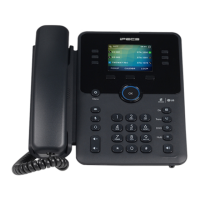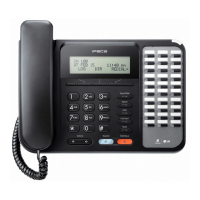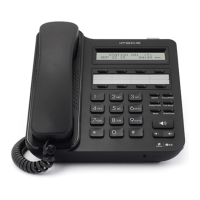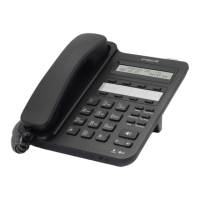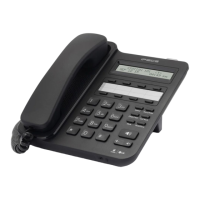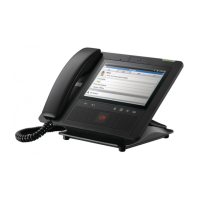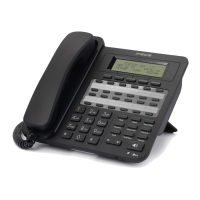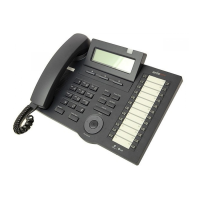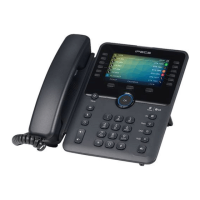Do you have a question about the LG-Ericsson iPECS eMG80 and is the answer not in the manual?
Provides detailed information on iPECS Release system software features and operation.
Features are arranged in nine major groupings for easy navigation and understanding.
Explains the structure of feature information including description, operation, conditions, programming, related features, and hardware.
Describes proprietary digital and IP phones, button designations, and common terms used.
Details the expansion capabilities for eMG80 and eMG100 systems using BKSU-IE/AE.
Describes the system's support for station numbering plans from two to eight digits.
Allows tracking of specific calls by entering a variable length identifier for cost allocation.
Configures the system to signal assigned iPECS IP and LDP Phones when an external contact activates.
Provides control over access to features like Voice Mail, Off Premise Call Forward, DISA.
Automatically records calls to a Voice Mailbox, UCS Client, or external server.
Automatically releases intercom or outside calls if dialing is not completed or not answered.
Incorporates flexible incoming call routing, agent monitoring, and call record statistics.
Allows requesting the system to retry a busy or no answer external call until connected.
Automatically pauses dialing a Speed Dial number to allow for potential connection delays.
Ensures privacy on all communications, allowing disabling of privacy for uninvited joining.
Defines ring assignments, COS, and answering privileges based on time of day.
Automatically adjusts system time for Daylight Saving Time (DST) forward or backward.
Automatically determines and sets the time of day using NTP or ISDN time messages.
Provides a tone indicating the elapsed time of a call has reached the Warning Tone time.
Allows selected incoming calls to be rerouted to other stations, groups, or outside lines.
Forwards calls to a pre-determined destination assigned in the system database.
Places an active internal or external call in a special holding location for easy access.
Allows answering incoming and transferred intercom and outside calls ringing at another station.
Permits authorized extensions to intrude into other existing calls, establishing a conference.
Detects line faults and automatically returns the line to service upon recovery.
Allows station to notify and screen calls sent to a voice mailbox.
Allows Attendant to determine and change active/standby CPU for system redundancy.
Allows SLT user to engage in two calls, alternating private conversations with each party.
Connects SIP phones through a VoIP channel using RFC-3261 SIP protocols.
Supports Standard and Premium UCS clients with UC features like call, IM, presence.
Enables call control using favorite station number (DSN) via NV or WV methods.
Provides mobile extension with native voice, controlling features via HTTP.
Details password setting fields for WEB login, Keyset Admin, and Remote Access.
Defines rules for strong passwords, including combinations, length, and consecutive characters.
Configures Authentication and Register modes to protect unauthorized SIP calls or registration.
Covers WEB password change and provisioning for ELG SIP phones.
Provides TLS Encryption mode for WEB ID/Password and WEB Admin.
Allows or denies packets by setting Protocol, Port, Source/Destination, and Source IP.
Controls Class of Service for stations and sets Toll table to prevent unwanted calls.
Provides recommendations for system security, including firewall usage.
Provides detailed information on iPECS Release system software features and operation.
Features are arranged in nine major groupings for easy navigation and understanding.
Explains the structure of feature information including description, operation, conditions, programming, related features, and hardware.
Describes proprietary digital and IP phones, button designations, and common terms used.
Details the expansion capabilities for eMG80 and eMG100 systems using BKSU-IE/AE.
Describes the system's support for station numbering plans from two to eight digits.
Allows tracking of specific calls by entering a variable length identifier for cost allocation.
Configures the system to signal assigned iPECS IP and LDP Phones when an external contact activates.
Provides control over access to features like Voice Mail, Off Premise Call Forward, DISA.
Automatically records calls to a Voice Mailbox, UCS Client, or external server.
Automatically releases intercom or outside calls if dialing is not completed or not answered.
Incorporates flexible incoming call routing, agent monitoring, and call record statistics.
Allows requesting the system to retry a busy or no answer external call until connected.
Automatically pauses dialing a Speed Dial number to allow for potential connection delays.
Ensures privacy on all communications, allowing disabling of privacy for uninvited joining.
Defines ring assignments, COS, and answering privileges based on time of day.
Automatically adjusts system time for Daylight Saving Time (DST) forward or backward.
Automatically determines and sets the time of day using NTP or ISDN time messages.
Provides a tone indicating the elapsed time of a call has reached the Warning Tone time.
Allows selected incoming calls to be rerouted to other stations, groups, or outside lines.
Forwards calls to a pre-determined destination assigned in the system database.
Places an active internal or external call in a special holding location for easy access.
Allows answering incoming and transferred intercom and outside calls ringing at another station.
Permits authorized extensions to intrude into other existing calls, establishing a conference.
Detects line faults and automatically returns the line to service upon recovery.
Allows station to notify and screen calls sent to a voice mailbox.
Allows Attendant to determine and change active/standby CPU for system redundancy.
Allows SLT user to engage in two calls, alternating private conversations with each party.
Connects SIP phones through a VoIP channel using RFC-3261 SIP protocols.
Supports Standard and Premium UCS clients with UC features like call, IM, presence.
Enables call control using favorite station number (DSN) via NV or WV methods.
Provides mobile extension with native voice, controlling features via HTTP.
Details password setting fields for WEB login, Keyset Admin, and Remote Access.
Defines rules for strong passwords, including combinations, length, and consecutive characters.
Configures Authentication and Register modes to protect unauthorized SIP calls or registration.
Covers WEB password change and provisioning for ELG SIP phones.
Provides TLS Encryption mode for WEB ID/Password and WEB Admin.
Allows or denies packets by setting Protocol, Port, Source/Destination, and Source IP.
Controls Class of Service for stations and sets Toll table to prevent unwanted calls.
Provides recommendations for system security, including firewall usage.
| Brand | LG-Ericsson |
|---|---|
| Model | iPECS eMG80 |
| Category | Telephone |
| Language | English |
